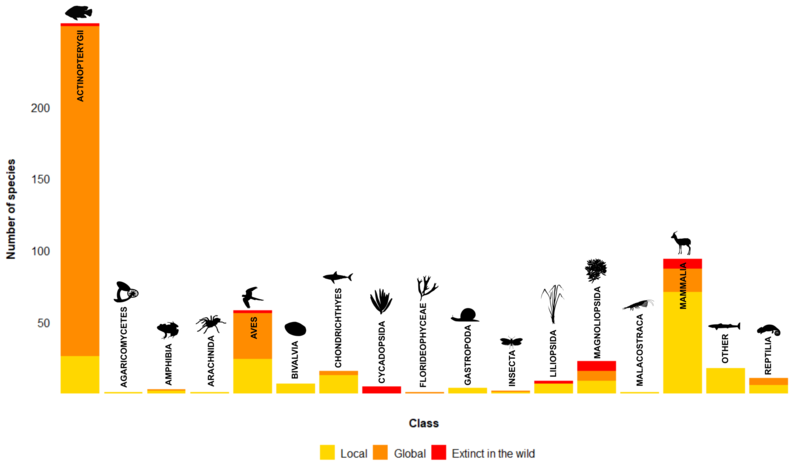The wildlife trade is often reported to be a major threat to wild species, but little is known about how many species have gone extinct, or are nearing extinction, as a result.
Researchers investigated examples of extinctions linked to trade by reviewing scientific publications and species listed as Extinct on the International Union for the Conservation of Nature’s Red List of Threatened Species. They found that over 500 species had been reported as extinct at some scale due to trade-related factors: 294 globally extinct, 25 extinct in the wild, and 192 locally extinct.
Extinctions were linked not only to direct harvesting, with indirect threats such as bycatch or introduced invasive species also playing a part. The majority of global and in the wild extinctions involved ray-finned fishes, primarily due to predation by introduced commercial species – such as the Nile perch, which was reported to have played a key role in the extinction of 200 cichlid fish species.

A graph showing the numbers of different species in different groups that have become locally extinct, globally extinct, or extinct in the wild, with their extinction linked to trade
However, it was often not possible to determine how significant a role trade-related threats played in extinctions. For example, reports rarely clarified whether harvesting was for the purpose of trade or subsistence, or when other threats such as habitat loss were likely to have played a more important role in an extinction. The results highlight the need for better data collection on trade-related extinction risk, to understand its impacts on species and populations plus inform more effective and sustainable wildlife trade policy. Dr Amy Hinsley, lead author of the study, said:
Trade is clearly linked to decline and extinction for some species, but often the links are not clear. We must avoid language that overstates threats of extinction, for example to charismatic mammals, as this could divert attention from species that are more at risk from trade but lesser known, such as plants. We must focus more on collecting clear evidence for the impact of trade on different target and non-target species.
There were very few recorded examples of extinctions linked to trade for plants or fungi, but as these groups are highly traded the impact is likely to be underestimated. Reporting bias favours well-known animals, such as recent high-profile global extinctions of rhinos; 41% of reported trade-linked local extinctions of animals were mammals. A further 340 species were reported to be near-extinct linked to trade, 79% of which were animals – including well-known wildlife such as pangolins and rhinos. Exaggerating trade as a threat for species with other, greater risks can also have consequences, potentially diverting attention and funding from species that most need it.
To read more about this research, published in CAMBRIDGE PRISMS: EXTINCTION, visit: https://doi.org/10.1017/ext.2023.7